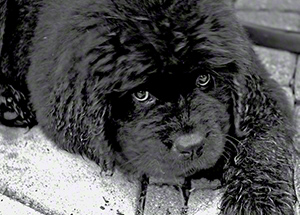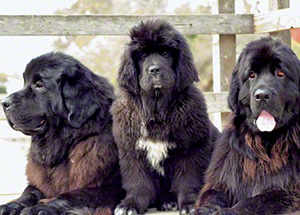A Newfoundland puppy needs to spend time outside exercising and exploring his new kingdom. As he grows, this circle of exploration increases, so too, do the possible dangers. Cars, garbage cans, children, wild animals, extreme heat and cold, and chemicals are a few examples of deadly encounters your pup may face if left to roam. For these, and many more reasons, an outside home should be constructed. Many factors should be considered when building a home for your new four-footed friend. This issue we will be start with the basics, location and fencing.
The major decision to made is: do we fence in the whole yard or just a portion. Ideally, a fenced in yard with a run inside is best. (When we use the term "run", we don't mean a wire strung from tree to tree, we mean an enclosure with four sides.) This way, when you are home, you can supervise your pups play in the yard. He can be taught not to dig in the flower beds, chew the vinyl siding, or the garden hose. When you are away, he can be safely placed in the run, away from all the hazards of the yard.
As with any type of construction, you should think about the weather. Are your normal temperatures hot, warm or cold? Do you have torrential rains? Blizzards? Which direction are the prevailing winds? These factors all enter into the placement of your pups run. If you live in the southern climates, you should consider an area that gets the most shade year round. If you live in the northern climates, where snow abounds, perhaps an area that is shaded during the summer months only. This would allow the sun to help melt the snow during the winter. No matter what your climate, there should always be a part of the run with shade. If you have no trees, this may be accomplished by covering the run with a tarp or sunblocking run cover. Try to plan the run around a big rock or tree. This breaks the monotony for the pup and gives him something fun to play with. Try to avoid square shapes as these tend to encourage "circling".
Next, give some thought to your neighbors (if you have any) and deliverymen. What will the run look like from their point of view? Will the pup be able to see them coming and going? Will this cause the pup to start barking? Will their children harass the pup? Will the run block access to the oil-fill pipe or the electric meter? How about the septic system? Giving a little thought to what your neighbors will see and hear may help "keep the peace" in the neighborhood.
Now that you have established the area, what about fencing? Stockade is so limiting, chainlink is too "security", picket isn't high enough. What about a combination of fences! Use stockade to give your back yard privacy, chainlink for the run and picket for the front yard. If using any type of fence (like 3 rail) with gaps between the boards, attach weld wire to cover the gaps. Think about where you will need gates and their size. Two strategically placed 8-10 ft. gates will allow nearly all types of trucks and equipment access to your yard. Whenever possible, use self-closing gates that open into your yard. This will help prevent your dogs escape because a gate was open and also keep your dog from pushing the gate open!
The size of the run greatly depends on the amount of time your pup will spend in it. The more time, the larger the run, the less time, the smaller. Minimum size, for proper exercise, is 12 ft. x 12 ft. Under no circumstances should the run be less than 6 ft. tall. While most Newfs are not "jumpers", past experience has shown that under certain circumstances a Newf will clear a 5 ft. fence. The first Newfoundland to receive the Ken-L Ration Dog Hero of the Year Award, Dirigos Magnificent Villa, CD, weighed 150 pounds and cleared a 5 ft. fence to save her "child", Andrea (Newf Tide, Spring 1984). My first Newf was half way over her 5 ft. run when our son fell an cut his face!
Should you decide to fence your yard before building a run, there are two very important rules to remember: NEVER put your pup in the yard with his collar on. Collars can easily become tangled and your pup may strangle himself. Also, NEVER leave your dog alone in a yard with less than 6 ft. high fencing. You never know when the neighborhood stray may bound over the fence or your dog might get into something he shouldn't!

